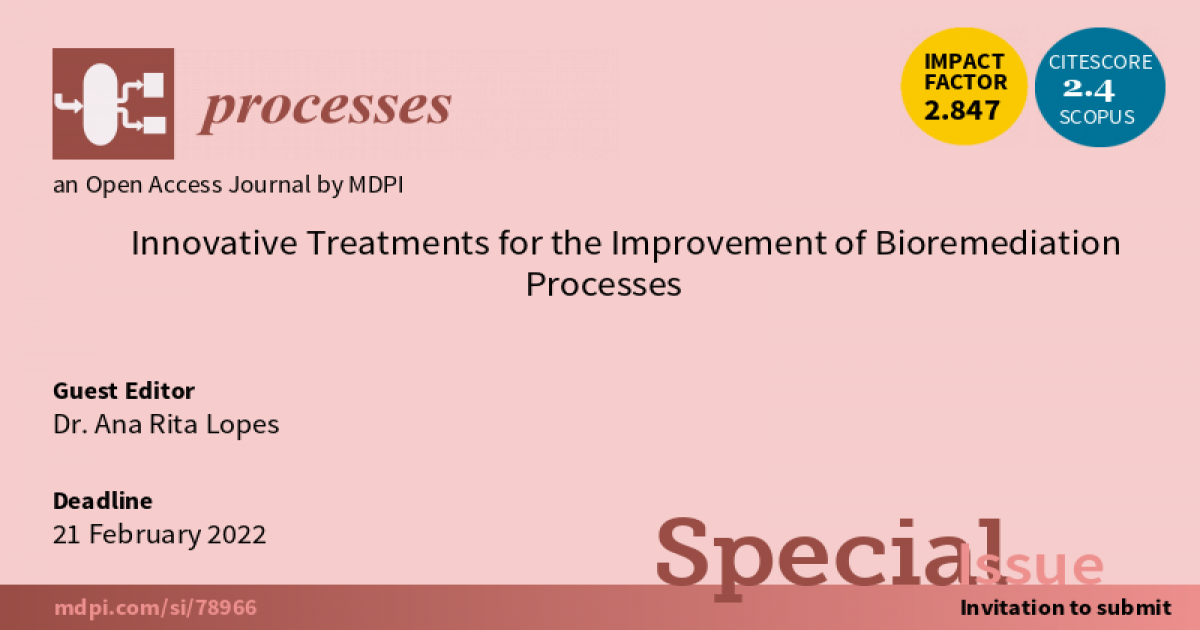Innovative Treatments for the Improvement of Bioremediation Processes
A special issue of Processes (ISSN 2227-9717). This special issue belongs to the section "Environmental and Green Processes".
Deadline for manuscript submissions: closed (21 February 2022) | Viewed by 20515

Special Issue Editor
Interests: environmental microbiology; microbial ecology; bioremediation; biocatalysts; green biotechnology; biotransformation; white biotechnology; bacterial genomics
Special Issue Information
Dear Colleagues,
Intense human activity has led to the spread of different pollutants in Earth ecosystems, impacting fauna and flora, consequently impacting human health. These pollutants are diverse in their structure and origin, including naturally occurring and synthetically created compounds (e.g., antibiotics, metals, petroleum hydrocarbons, pesticides, plastics, perfluorinated compounds). Hence, their treatment is complex and faces different physicochemical and biological challenges; these include the bioavailability or accessibility of the pollutant, its biodegradability and the potential accumulation of toxic compounds as a result of the biodegradation of the parent compound. In addition, the adaptability and maintenance of the degrading organism(s), among others, result in the need for an in-depth characterization of the degrading organism(s) (e.g., growth kinetics, metabolic activity, and genetic makeup). This complexity urges us to create solutions that integrate knowledge gathered from distinct fields, such as microbiology, plant biology, chemistry, geology, environmental engineering, and bioengineering, among others. The solutions might be driven by the identification of novel biological routes to degrade a pollutant or by the development of a new bioremediation tool. The latter might result from the modification of a known biocatalyst (e.g., organism, enzyme) or the combination of biological and chemical processes, creating a hybrid system that overcomes the drawbacks of both, maximizing the efficiency of the remediation process.
This Special Issue on "Innovative Treatments for the Improvement of Bioremediation Processes" seeks high-quality research and case studies focusing on developing and applying novel bioremediation strategies.
Topics include but are not limited to:
- Identification and characterization of novel degrading metabolic pathways;
- Development of novel bioremediation treatments, modifying existing biocatalysts (e.g., microorganism(s), enzyme(s));
- Development of hybrid bioremediation systems coupling chemical and biological strategies, optimizing the activity of existing biocatalysts (e.g., plant, microorganism(s), enzyme(s)).
Dr. Ana Rita Lopes
Guest Editor
Manuscript Submission Information
Manuscripts should be submitted online at www.mdpi.com by registering and logging in to this website. Once you are registered, click here to go to the submission form. Manuscripts can be submitted until the deadline. All submissions that pass pre-check are peer-reviewed. Accepted papers will be published continuously in the journal (as soon as accepted) and will be listed together on the special issue website. Research articles, review articles as well as short communications are invited. For planned papers, a title and short abstract (about 250 words) can be sent to the Editorial Office for assessment.
Submitted manuscripts should not have been published previously, nor be under consideration for publication elsewhere (except conference proceedings papers). All manuscripts are thoroughly refereed through a single-blind peer-review process. A guide for authors and other relevant information for submission of manuscripts is available on the Instructions for Authors page. Processes is an international peer-reviewed open access monthly journal published by MDPI.
Please visit the Instructions for Authors page before submitting a manuscript. The Article Processing Charge (APC) for publication in this open access journal is 2400 CHF (Swiss Francs). Submitted papers should be well formatted and use good English. Authors may use MDPI's English editing service prior to publication or during author revisions.
Keywords
- bioremediation
- degradation pathways
- redox processes
- phytoremediation
- biostimulation
- green biotechnology
- environmental engineering
- geochemistry
- biocatalysts
Benefits of Publishing in a Special Issue
- Ease of navigation: Grouping papers by topic helps scholars navigate broad scope journals more efficiently.
- Greater discoverability: Special Issues support the reach and impact of scientific research. Articles in Special Issues are more discoverable and cited more frequently.
- Expansion of research network: Special Issues facilitate connections among authors, fostering scientific collaborations.
- External promotion: Articles in Special Issues are often promoted through the journal's social media, increasing their visibility.
- Reprint: MDPI Books provides the opportunity to republish successful Special Issues in book format, both online and in print.
Further information on MDPI's Special Issue policies can be found here.





